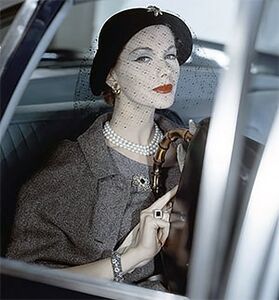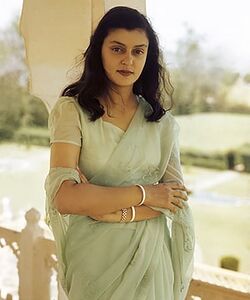Mişeyáqueens
The Mişeyáqueens was a group of influential socialites, salonnières, and art patrons active in Mişeyáke during the Golden Revolution. They had a major influence on the city's culture and artistic scene, and shaped its image in Gylias.
Etymology
The name is a portmanteau of "Mişeyáke" and "queens". It emerged as a simplification of the nickname "Queens of Mişeyáke", by analogy with "tessai".
Members
Jane Russell
(1933–2009)
Origins
The group members came from varied origins. Gayatri Devi, the oldest member, was a Tennaiite princess who served as an ambassador to the Free Territories and Gylias. Jana Friedman and Jane Russell were of Shalumite descent and had moved to the Free Territories. Anja Brandt, the youngest member, was Delkoran and arrived in the Free Territories with her parents, who served in the International Brigades.
Activities
The Mişeyáqueens settled in Mişeyáke when it began to be constructed as a planned capital after the Liberation War. Gayatri, as the incumbent ambassador, was the catalyst in bringing the group together, as she befriended the other three.
The fact that Mişeyáke was being built from scratch practically provided the group a "blank canvas", in Doortje Koelewijn's words, as they "dreamed up a very attractive idea of what Mişeyáke should be, and seized the initiative before any competition emerged".
They engaged in a variety of activities around Mişeyáke, including modeling, acting, business, and civic activism, and built up a prominent media profile. Jana and Jane founded Sibylla, which became a renowned nightclub, and Anja founded the Mişeyáke Metro Mail, which became one of the city's leading publications, and the main vehicle for expressing their populist, aristerokratia-oriented vision of the capital.
Esua Nadel, who helped popularise the term "queens of Mişeyáke" in jest, commented that they "knew how to have the press eat out of the palm of their hand, built up financial resources for their pet projects, and became the people to be seen in Mişeyáke." They were celebrated members of the community, part of the tradition of the mauve circle and Virginia Castiglione, and contemporaneous with other aristerokratia taste-makers such as the Tessai. They enjoyed notably close relations with long-serving Mayor Arau Kanac, who shared their vision.
The Mişeyáqueens had a significant impact on Mişeyáke. They helped make the "magic tetragon" — an area containing Sibylla, Annemarie Beaulieu's studio L'Usine, Ludmila Canaşvili's salon, and the Mişeyáke Metro Mail building — the centre of the capital's cultural scene and nightlife. They shaped the city's image of itself and in Gylias, making it a cultural hot spot at the forefront of the Groovy Gylias scene, and embracing an ethos that combined socialised luxury with demopolitan planning. Gayatri was also notable for her efforts to promote Tennaiite culture in Gylias, efforts which paid off after the "psychedelic revolution" and emergence of Tennaiite-influenced psychedelic music.
Gayatri was largely retired in her last years before her death in 2009, while Jana and Jane remained involved with Sibylla until their deaths, gradually passing the torch to a trusted new generation of Sibylla management. Anja, the last surviving member of the Mişeyáqueens, remains involved in the Mişeyáke Metro Mail and in acting and modeling. Mayor Lisa d'Arville commented in 2004, "Without the Mişeyáqueens' vision and initiative, Mişeyáke wouldn't be the city we know today."



